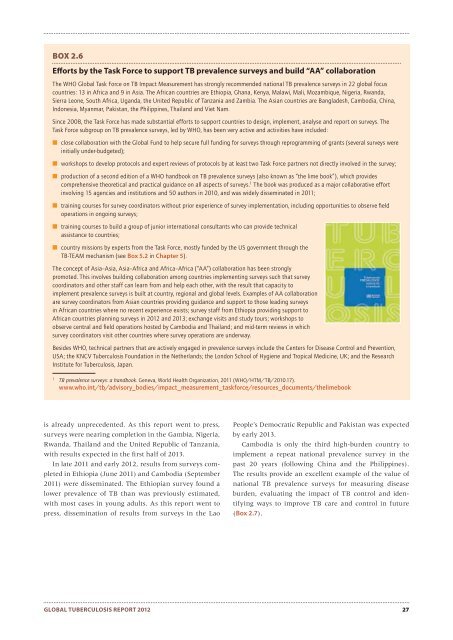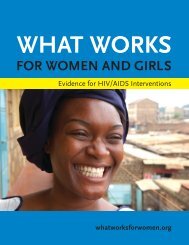Global Tuberculosis Report -- 2012.pdf
Global Tuberculosis Report -- 2012.pdf
Global Tuberculosis Report -- 2012.pdf
Create successful ePaper yourself
Turn your PDF publications into a flip-book with our unique Google optimized e-Paper software.
BOX 2.6Efforts by the Task Force to support TB prevalence surveys and build “AA” collaborationThe WHO <strong>Global</strong> Task Force on TB Impact Measurement has strongly recommended national TB prevalence surveys in 22 global focuscountries: 13 in Africa and 9 in Asia. The African countries are Ethiopia, Ghana, Kenya, Malawi, Mali, Mozambique, Nigeria, Rwanda,Sierra Leone, South Africa, Uganda, the United Republic of Tanzania and Zambia. The Asian countries are Bangladesh, Cambodia, China,Indonesia, Myanmar, Pakistan, the Philippines, Thailand and Viet Nam.Since 2008, the Task Force has made substantial efforts to support countries to design, implement, analyse and report on surveys. TheTask Force subgroup on TB prevalence surveys, led by WHO, has been very active and activities have included:■ close collaboration with the <strong>Global</strong> Fund to help secure full funding for surveys through reprogramming of grants (several surveys wereinitially under-budgeted);■ workshops to develop protocols and expert reviews of protocols by at least two Task Force partners not directly involved in the survey;■ production of a second edition of a WHO handbook on TB prevalence surveys (also known as “the lime book”), which providescomprehensive theoretical and practical guidance on all aspects of surveys. 1 The book was produced as a major collaborative effortinvolving 15 agencies and institutions and 50 authors in 2010, and was widely disseminated in 2011;■ training courses for survey coordinators without prior experience of survey implementation, including opportunities to observe fi e ldoperations in ongoing surveys;■ training courses to build a group of junior international consultants who can provide technicalassistance to countries;■ country missions by experts from the Task Force, mostly funded by the US government through theTB-TEAM mechanism (see Box 5.2 in Chapter 5).The concept of Asia–Asia, Asia–Africa and Africa–Africa (“AA”) collaboration has been stronglypromoted. This involves building collaboration among countries implementing surveys such that surveycoordinators and other staff can learn from and help each other, with the result that capacity toimplement prevalence surveys is built at country, regional and global levels. Examples of AA collaborationare survey coordinators from Asian countries providing guidance and support to those leading surveysin African countries where no recent experience exists; survey staff from Ethiopia providing support toAfrican countries planning surveys in 2012 and 2013; exchange visits and study tours; workshops toobserve central and fi eld operations hosted by Cambodia and Thailand; and mid-term reviews in whichsurvey coordinators visit other countries where survey operations are underway.Besides WHO, technical partners that are actively engaged in prevalence surveys include the Centers for Disease Control and Prevention,USA; the KNCV <strong>Tuberculosis</strong> Foundation in the Netherlands; the London School of Hygiene and Tropical Medicine, UK; and the ResearchInstitute for <strong>Tuberculosis</strong>, Japan.1TB prevalence surveys: a handbook. Geneva, World Health Organization, 2011 (WHO/HTM/TB/2010.17).www.who.int/tb/advisory_bodies/impact_measurement_taskforce/resources_documents/thelimebookis already unprecedented. As this report went to press,surveys were nearing completion in the Gambia, Nigeria,Rwanda, Thailand and the United Republic of Tanzania,with results expected in the first half of 2013.In late 2011 and early 2012, results from surveys completedin Ethiopia (June 2011) and Cambodia (September2011) were disseminated. The Ethiopian survey found alower prevalence of TB than was previously estimated,with most cases in young adults. As this report went topress, dissemination of results from surveys in the LaoPeople’s Democratic Republic and Pakistan was expectedby early 2013.Cambodia is only the third high-burden country toimple ment a repeat national prevalence survey in thepast 20 years (following China and the Philippines).The results provide an excellent example of the value ofnational TB prevalence surveys for measuring diseaseburden, evaluating the impact of TB control and identifyingways to improve TB care and control in future(Box 2.7).GLOBAL TUBERCULOSIS REPORT 2012 27
















